A Study on the Measurement of Comparative Advantage of Land Use Efficiency, Spatiotemporal Heterogeneity and Its Influencing Factors—An Empirical Test from the Panel Data of China’s Provincial Sub-Industry Types
Abstract
:1. Introduction
2. Theoretical Basis Analysis
2.1. Basic Conditions for the Theory Application
2.2. Deduction of Theoretical Hypothesis
3. Model Algorithms and Data Sources
3.1. Land Use Efficiency Evaluation Model
3.2. Comparative Advantage Model
3.3. Spatial Analysis Model of Comparative Advantage of Land Use Efficiency
3.4. Identification Model of Influencing Factors of Comparative Advantage of Land Use Efficiency
3.5. Index System and Data Source of Land Use Efficiency Evaluation
4. Results and Analysis
4.1. Land Use Efficiency Analysis
4.2. Comparative Advantage Analysis of Land Use Efficiency
4.3. Spatial Analysis of Comparative Advantage of Land Use Efficiency
4.4. Analysis of Influencing Factors of Comparative Advantage of Land Use Efficiency
5. Conclusions and Discussion
5.1. Discussion
5.2. Conclusions
Author Contributions
Funding
Institutional Review Board Statement
Informed Consent Statement
Data Availability Statement
Conflicts of Interest
References
- Tang, Y.K.; Yang, Y.F.; Xu, H. The Impact of China Carbon Emission Trading System on Land Use Transition: A Macroscopic Economic Perspective. Land 2021, 11, 41. [Google Scholar] [CrossRef]
- Shao, S.; Fan, M.T.; Yang, L.L. Economic Restructuring, Green Technology Progress and China’s Low-carbon Transformation and Development: An Empirical Examination Based on the Perspective of Overall Technology Frontier and Spatial Spillover Effect. Manag. World 2022, 38, 46–69. [Google Scholar]
- He, L.; Wang, B.P.; Xu, W.T.; Cui, Q.; Chen, H. Could China’s long-term low-carbon energy transformation achieve the double dividend effect for the economy and environment. Environ. Sci. Pollut. Res. Int. 2021, 29, 20128–20144. [Google Scholar] [CrossRef]
- Liang, X.Y.; Jin, X.B.; Sun, R.; Hang, B.; Ren, J.; Zhou, Y.K. Elastic space for cultivated land conservation in China under the constraints of the bottom line of multi-scenario food security. Acta Geogr. Sin. 2022, 77, 697–713. [Google Scholar]
- Cao, Y.; Li, G.Y.; Wang, J.Y.; Fang, X.Q.; Sun, K.Y. Systematic cognition and research framework of non-food cultivated land: From food security to multidimensional security. China Land Sci. 2022, 36, 1–12. [Google Scholar]
- Huang, Z.H.; Li, Y.Y.; Mao, X.H. The current situation and countermeasures of “non-agriculture” and “non-grain” of cultivated land in China. JAC Forum 2022, 4, 13–21. [Google Scholar]
- Tang, H.Z.; Sang, L.L.; Yun, W.J. China’s arable land to supplement balance policy implementation dilemma and scientific and technological innovation direction. Proc. Chin. Acad. Sci. 2020, 5, 637–644. [Google Scholar]
- Tang, M.; Shao, L. Arable land protection policy and local government land transfer behavior. J. Financ. Econ. 2022, 48, 123–137. [Google Scholar]
- Jiang, K.H.; Chen, J.L.; Chen, W. Comparative Advantage Theory and Regional Land Resource Allocation: A Case Study of Jiangsu Province. China Rural. Econ. 2004, 12, 16–21. [Google Scholar]
- Zhu, Z.; Zhang, L.; Ye, X.W.; Zhang, Y. Comprehensive efficiency evaluation of land use based on TOPSIS method. Econ. Geogr. 2012, 32, 139–144. [Google Scholar]
- Gu, X.; Qu, F.T.; Fu, G.H. China’s comparative advantages in land use and regional industrial restructuring. China Land Sci. 2009, 23, 61–65. [Google Scholar]
- Li, Y.; Sun, Z.G.; Liu, E.Y.; Shao, C.X. Spatial-temporal evolution analysis of regional breeding structure in China based on the theory of comparative advantage. J. Nat. Resour. 2021, 36, 1149–1162. [Google Scholar]
- Edjah, B.K.T.; Wu, J.P.; Tian, J.J. Research on the Comparative Advantage and Complementarity of China–Ghana Agricultural Product Trade. Sustainability 2022, 14, 13136. [Google Scholar] [CrossRef]
- Deng, X.G.; Cao, H. Industrial Upgrading Path Selection: Following or Deviating from Comparative Advantage: An Empirical Analysis Based on Product Space Structure. China Ind. Econ. 2016, 2, 52–67. [Google Scholar]
- Wang, B.X.; Zhou, Y.C. Research on land resource allocation efficiency in Zhejiang Province based on comparative advantages. Econ. Geogr. 2017, 7, 185–190. [Google Scholar]
- Bi, B.D. Land Economics, 4th ed.; China Renmin University Press: Beijing, China, 2002. [Google Scholar]
- Jiang, Z.D. Territorial allocation and layout strategy of land use in China. China Agric. Resour. Zoning 2004, 1, 8–11. [Google Scholar]
- Shi, J.; Huang, Z.J.; He, C.F.; Wang, W.K. Comprehensive evaluation of land use efficiency in urban agglomerations in China. Econ. Geogr. 2013, 33, 76–81. [Google Scholar]
- Lin, Y.F. New Structural Economics–Restructuring the Framework of Development Economics. Econ. (Q.) 2011, 10, 1–32. [Google Scholar]
- Qiu, J.D.; Zhao, J.F.; Wu, J.S. Measurement of regional land use efficiency level in China based on coupling relationship. Chin. Resour. Environ. 2012, 22, 103–110. [Google Scholar]
- Zhao, T.; Chen, Z. Comparative Advantage and Industrial Policy Effect: Regional Differences and Institutional Causes. Soc. Sci. Dig. 2020, 19, 777–796. [Google Scholar]
- Wang, J.G.; Yang, L.Z.; Ma, Y.J. Comparative Advantage and Land Use: A Case Study of Southern Jiangsu. Soil 2002, 4, 185–190. [Google Scholar]
- Research Group of the Investment Research Institute of the National Planning Commission; the Regional Institute of Renmin University of China. Research on China’s Regional Comparative Advantage. Manag. World 2001, 2, 45–55. [Google Scholar]
- Li, Z.Q.; Li, X.Y.; Wang, J.X. The Causes of Spatial Mismatch between Food Production and Water Resources: Based on the Theory of Comparative Advantage. J. China Agric. Univ. 2022, 27, 12–29. [Google Scholar]
- Lin, Y.F.; Fu, C.H. Comparative Advantage and Competitive Advantage: A Perspective from New Structural Economics. Econ. Res. Stream 2022, 57, 23–33. [Google Scholar]
- Wang, M.T.; Ye, C.M.; Zhang, D.K. Evaluation of Green Manufacturing Level in China’s Provincial Administrative Regions Based on Combination Weighting Method and TOPSIS. Sustainability 2022, 14, 13690. [Google Scholar] [CrossRef]
- Xu, M.; Xu, J.; Wang, Y.S.; Tang, J.; Wu, B.; Xie, Y.J. Construction safety evaluation of TOPSIS metro station based on CRITIC method. J. Nat. Disasters 2022, 31, 157–166. [Google Scholar]
- Stiglitz, E. Economics, 2nd ed.; China Renmin University Press: Beijing, China, 2000. [Google Scholar]
- Li, D.C.; Fan, K.K.; Lu, J.Q.; Wu, S.; Xie, X.W. Research on Spatio-Temporal Pattern Evolution and the Coupling Coordination Relationship of Land-Use efficiency from a Low-Carbon Perspective: A Case Study of Fujian Province. Land 2022, 11, 1498. [Google Scholar] [CrossRef]
- Sun, H.Y.; Cheng, L.L.; Li, Z.; Wang, Q.Y.; Teng, J.H. A land-use efficiency evaluation system with case study verification. PLoS ONE 2022, 17, e0271557. [Google Scholar]
- Fan, S.P.; Liu, Y.Z.; Cheng, J.M.; Ding, Z.; Zhang, B.E. The degree of response of land use efficiency to industrial structure upgrading in the transition period and its impact mechanism. Chin. J. Soil Sci. 2021, 52, 1034–1041. [Google Scholar]
- Su, H.; Chen, Y.M.; Tan, H.Y.; Zhou, A.N.; Chen, G.D.; Chen, Y.J. Estimating Regional PM2.5 Concentrations in China Using a Global-Local Regression Model Considering Global Spatial Autocorrelation and Local Spatial Heterogeneity. Remote Sens. 2022, 14, 4545. [Google Scholar] [CrossRef]
- Getis, A.; Ord, J.K. The analysis of spatial association by use of distance statistics. Geogr. Anal. 1992, 24, 189–206. [Google Scholar] [CrossRef]
- Fan, S.P.; Liu, Y.Z.; Cheng, C.K.; Zhang, H.M.; Zhong, T.Y. Measurement and comprehensive judgment of land use efficiency in Chaohu Basin. Soil 2017, 49, 838–845. [Google Scholar]
- Turner, B.L., II; Clark, W.C.; Kates, R.W.; Richards, J.F.; Mathews, J.T.; Meyer, W.B. The Earth as Transformed by Human Action: Global and Regional Changes in the Biosphere over the Past 300 Years; Cambridge University Press: Cambridge, UK; New York, NY, USA, 1990. [Google Scholar]
- Gao, S.; Li, Z.; Chen, M.Y.; Lin, P.R.; Hong, Z.; Allen, D.; Neeson, T.; Hong, Y. Spatiotemporal variability of global river extent and the natural driving factors revealed by decades of Landsat observations, GRACE gravimetry observations, and land surface model simulations. Remote Sens. Environ. 2021, 267, 112725. [Google Scholar] [CrossRef]
- Bănăduc, D.; Marić, S.; Cianfaglione, K.; Afanasyev, S.; Somogyi, D.; Nyeste, K.; Antal, L.; Koščo, J.; Ćaleta, M.; Wanzenböck, J.; et al. Steppingstone Wetlands, Last Sanctuaries for European Mudminnow: How Can the Human Impact, Climate Change, and Non-Native Species Drive a Fish to the Edge of Extinction. Sustainability 2022, 14, 13493. [Google Scholar] [CrossRef]
- Xie, C.Y.; Hu, H.H. Land Resource Allocation and Urban Innovation in China: Mechanism Discussion and Empirical Evidence. China Ind. Econ. 2020, 12, 83–101. [Google Scholar]
- Liu, J.Y.; Kuang, W.H.; Zhang, Z.X.; Xu, X.L.; Qi, Y.W.; Ning, J.; Zhou, W.C.; Zhang, S.W.; Li, R.D.; Yan, C.Z.; et al. The basic characteristics and spatial pattern of land use change in China since the 80s of the 20th centuries. J. Geogr. Sci. 2014, 24, 195–210. [Google Scholar] [CrossRef]
- Li, L.X.; Shen, G.J. Economic Development Zones, Regional Comparative Advantages and Industrial Structure Adjustment. Econ. (Q.) 2015, 14, 885–910. [Google Scholar]
- Zhu, W.J.; Sun, H. Spatiotemporal evolution and driving force of urban land use efficiency in Jiangsu Province. China Land Sci. 2019, 33, 103–112. [Google Scholar]
- Xiang, S.L.; Tian, R.Z. Biased Technological Progress and Dynamic Comparative Advantage: Theory and Chinese Industry Experience. Econ. Rev. 2020, 5, 44–62. [Google Scholar]
- Liu, J.Y.; Ning, J.; Kuang, W.H.; Xu, X.L.; Zhang, S.W.; Yan, C.Z.; Li, R.D.; Wu, S.X.; Hu, Y.F.; Du, G.M.; et al. Spatial-temporal pattern and new characteristics of land use change in China from 2010 to 2015. Acta Geogr. Sin. 2018, 73, 789–802. [Google Scholar]
- Ji, X.M.; Wang, K.; Ji, T.; Zhang, Y.H. Coupling Analysis of Urban Land Use efficiency: A Case Study of Xiamen City. Land 2020, 9, 155. [Google Scholar] [CrossRef]
- Xia, H.; Yuan, S.F.; Yang, L.X. Research on the spatial pattern evolution and driving factors of land economic efficiency in Zhejiang County. Resour. Environ. Yangtze Basin 2017, 26, 341–349. [Google Scholar]
- Wang, K.; Tang, Y.K.; Chen, Y.Z.; Shang, L.W.; Ji, X.M.; Yao, M.C.; Wang, P. The Coupling and Coordinated Development from Urban Land Using efficiency and Urbanization Level: Case Study from Fujian Province (China). Int. J. Environ. Res. Public Health 2020, 17, 5647. [Google Scholar] [CrossRef]
- Liao, J.; Peng, X.; Wang, Q.; Jian, P.; Wu, Q. Study on the coupling and coordination relationship of urban land use efficiency in urban agglomeration on the west coast of Taiwan Strait. World Reg. Stud. 2021, 30, 556–566. [Google Scholar]
- Hu, Y.; Qiao, W.; Wan, Y.; He, T.; Chai, Y.; Bi, Y. Comprehensive Evaluation and Spatial Distinction of Land Use efficiency in County Area of Jiangsu Province. Econ. Geogr. 2020, 40, 186–195. [Google Scholar]

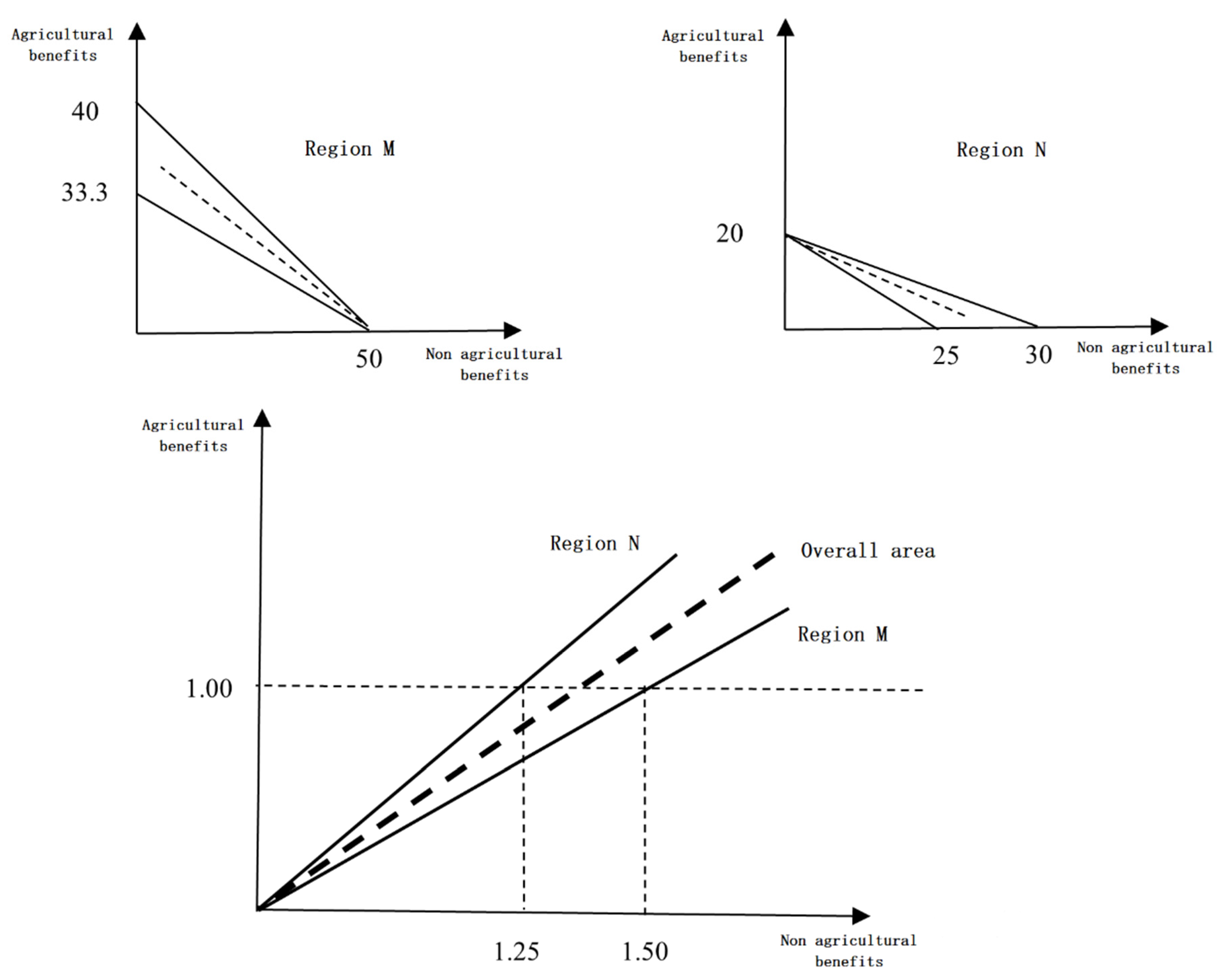


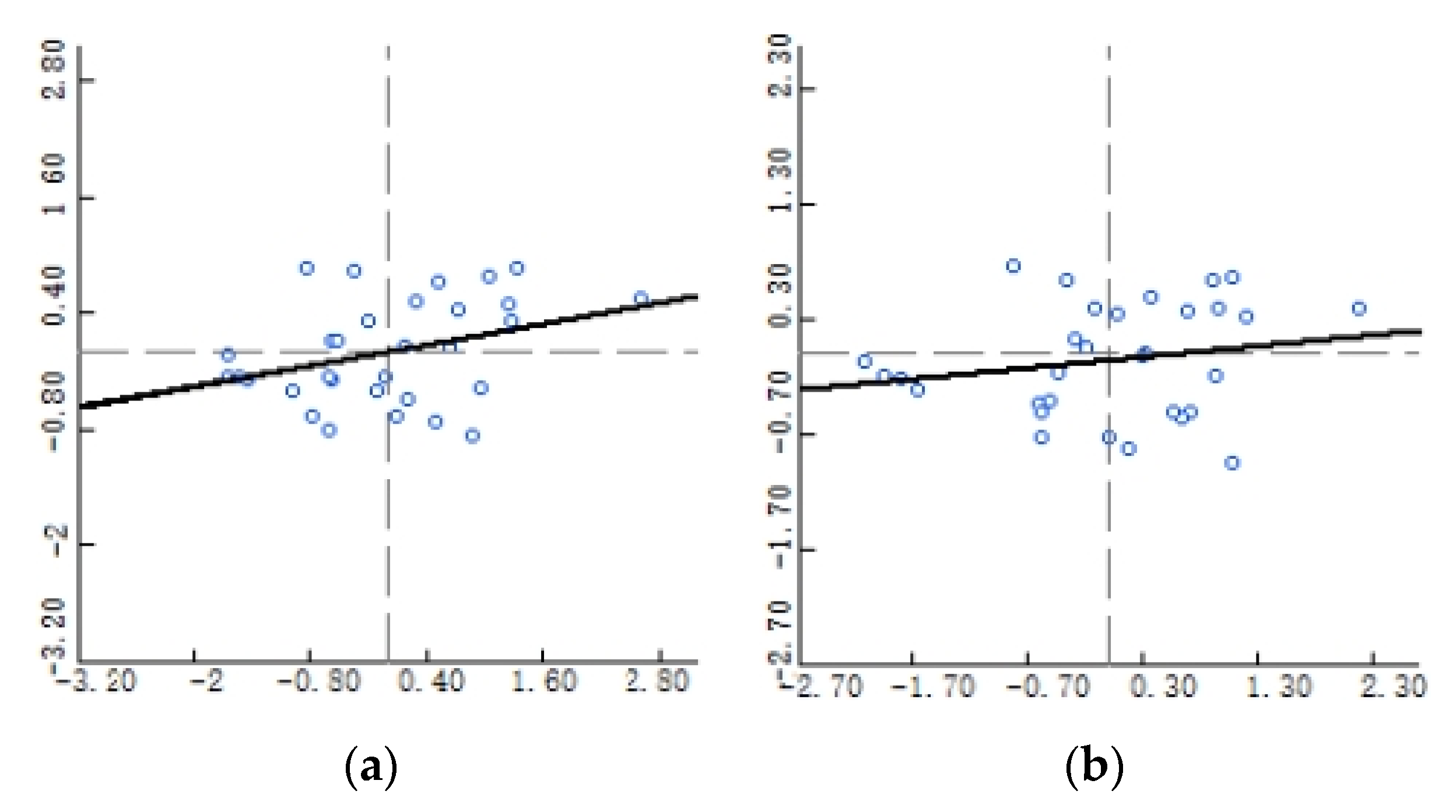
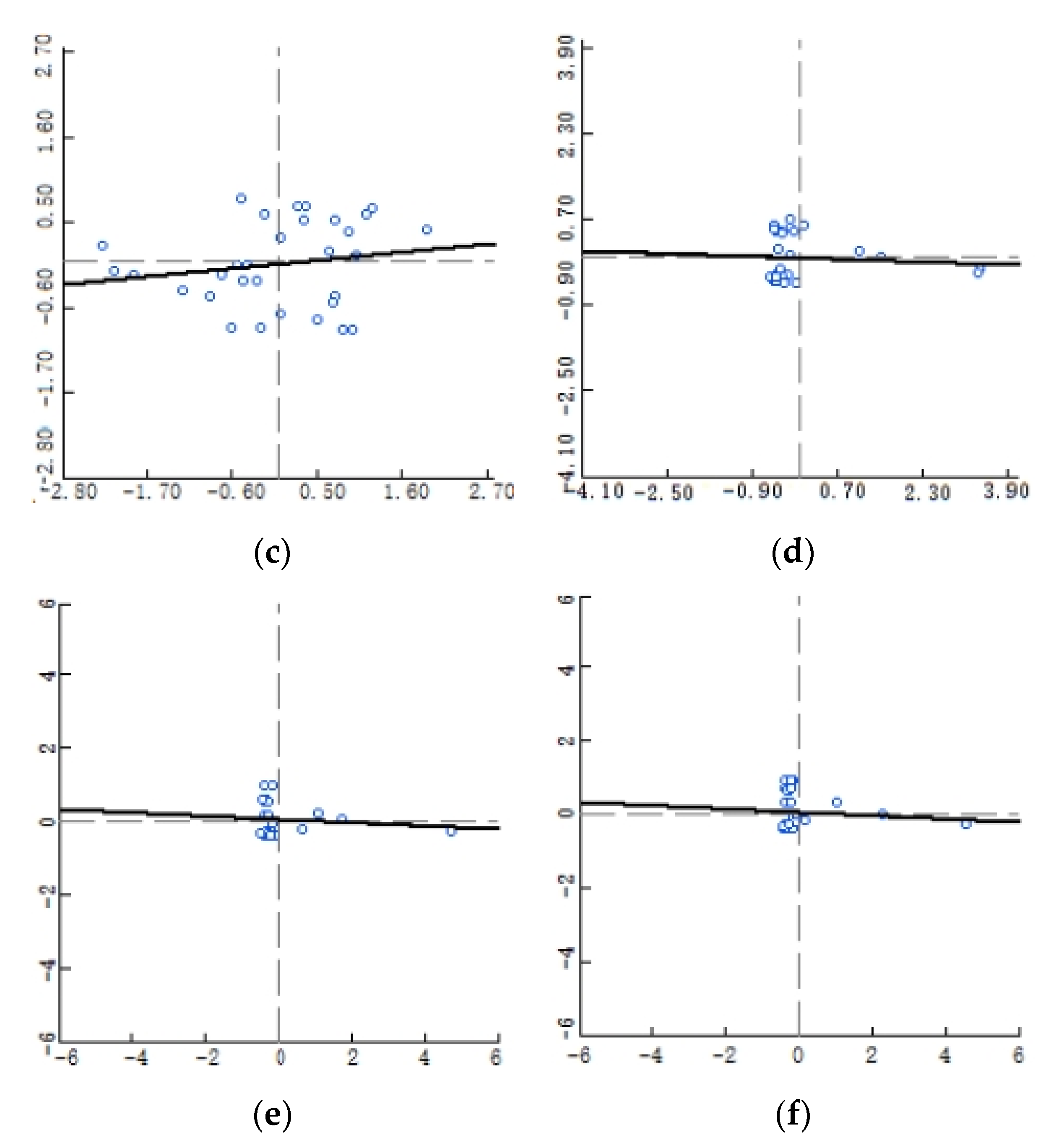

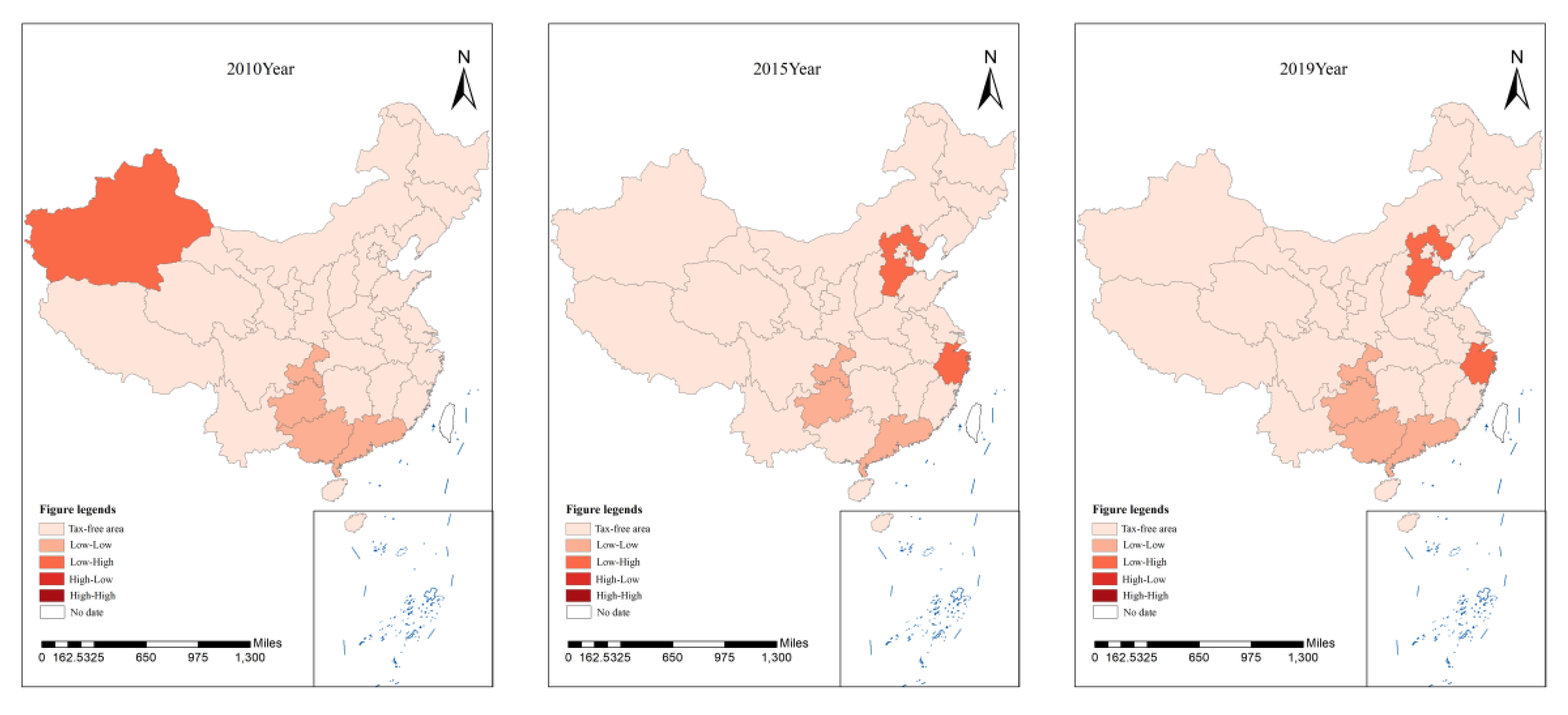
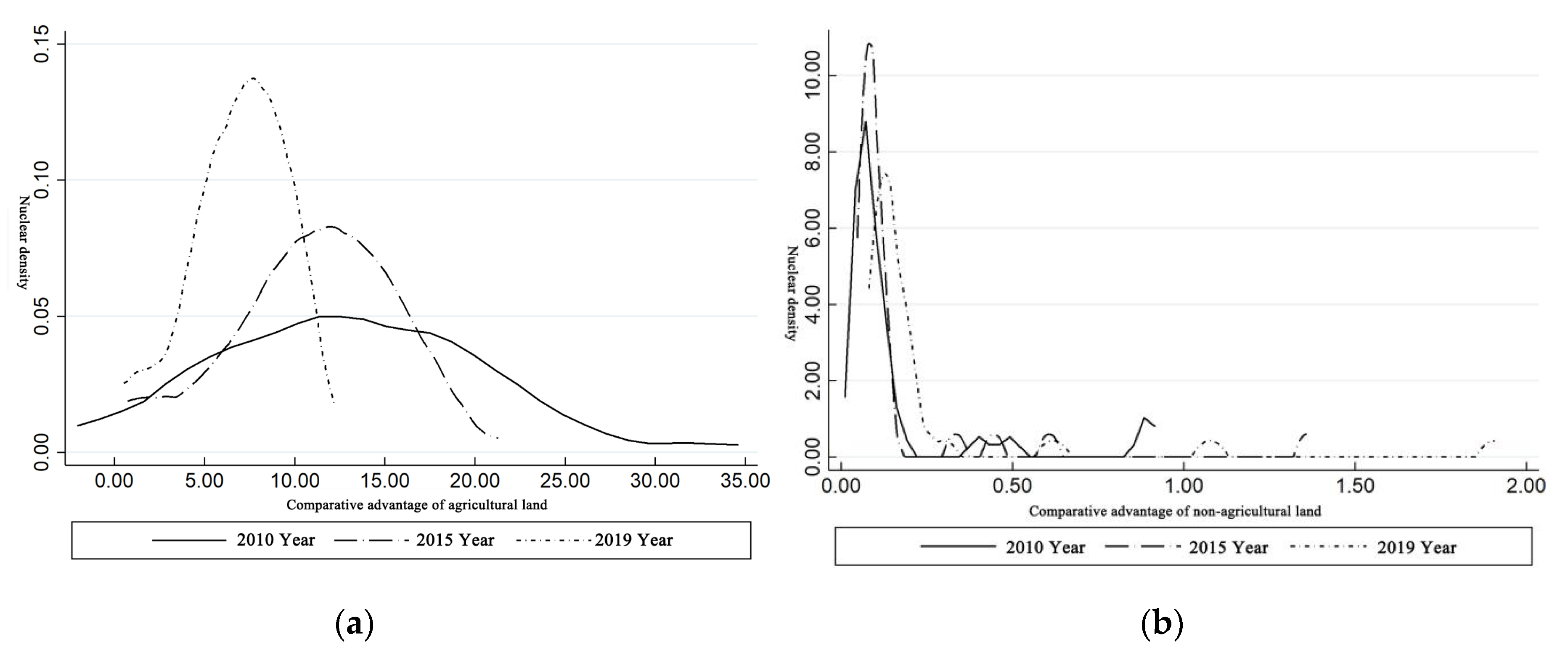
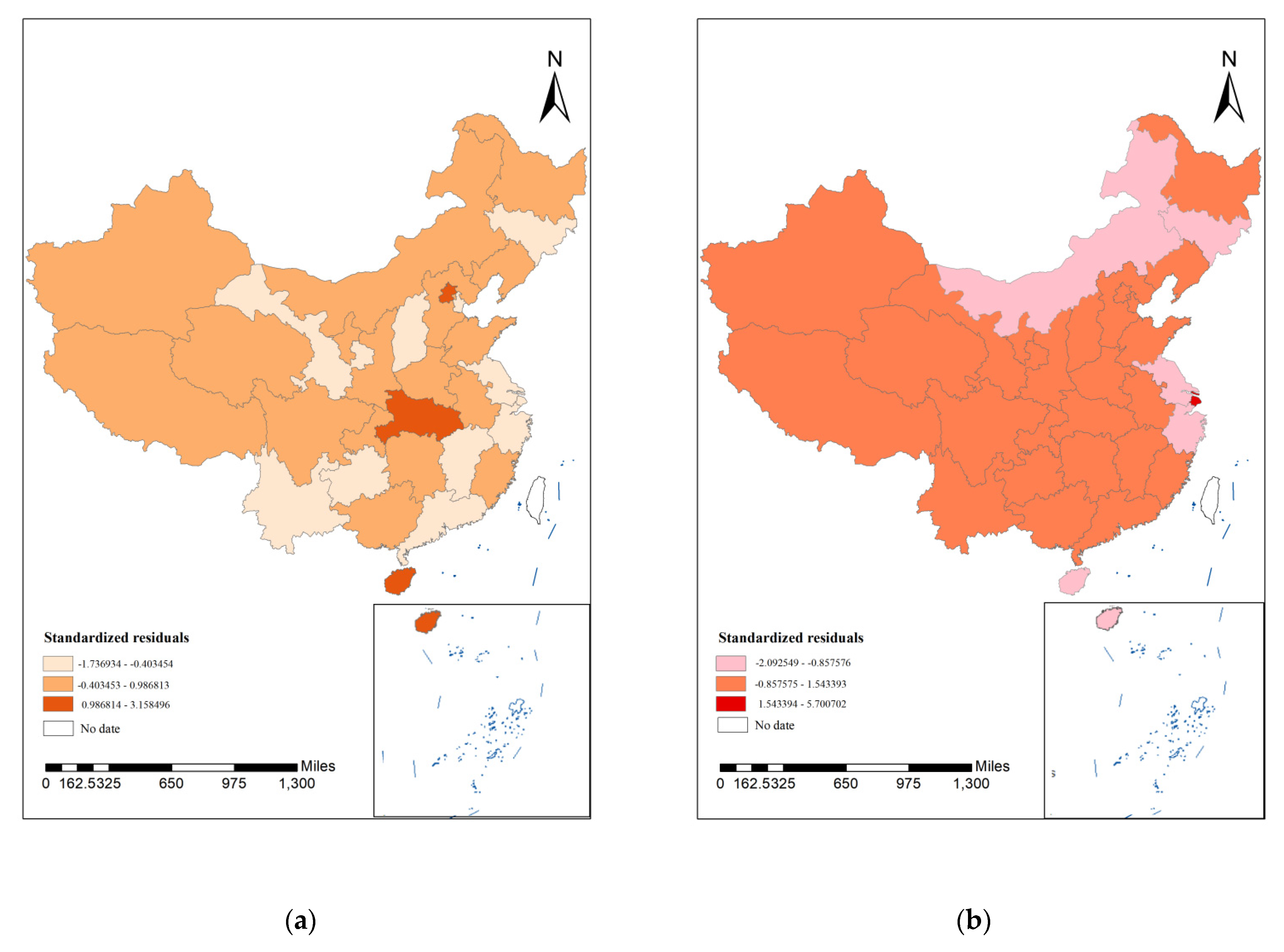


| Product (Efficiency) | Area M | Area N |
|---|---|---|
| 1 unit AB | 3 hectares | 5 hectares |
| 1 unit NAB | 2 hectares | 4 hectares |
| Total Target Layer | Sub-Target Layer | Indicator Layer | Information Entropy ej | Redundancy dj | Weight wj |
|---|---|---|---|---|---|
| Land use efficiency Evaluation (IB) | Efficiency evaluation of Agricultural land (IB agriculture) | Land average output value of primary industry (IB agriculture 1) | 0.9361 | 0.0639 | 0.2513 |
| Average agricultural added value (IB agriculture 2) | 0.9347 | 0.0653 | 0.257 | ||
| Per capita disposable income of rural residents (IB agriculture 3) | 0.9419 | 0.0581 | 0.2288 | ||
| Per capita consumption and expenditure of rural residents (IB agriculture 4) | 0.9332 | 0.0668 | 0.2629 | ||
| Efficiency evaluation of non- agricultural land (IB non agricultural) | Land average output value of secondary and tertiary industries (IB non-agricultural 1) | 0.7388 | 0.2612 | 0.3590 | |
| Non-agricultural level (IB non agricultural 2) | 0.9809 | 0.0191 | 0.0262 | ||
| Average wage of employees in urban units (IB non-agricultural 3) | 0.9303 | 0.0697 | 0.0958 | ||
| Per capita consumption expenditure of urban residents (IB non agricultural 4) | 0.937 | 0.063 | 0.0866 | ||
| Average local fiscal revenue (IB non agricultural 5) | 0.6987 | 0.3013 | 0.4143 | ||
| Greening coverage rate of built-up area (IB non agricultural 6) | 0.9868 | 0.0132 | 0.0181 |
| Evaluation Unit | Efficiency Evaluation of Agricultural Land (IB agriculture) | Efficiency Evaluation of Non-Agricultural Land (IB non agricultural) | ||||
|---|---|---|---|---|---|---|
| 2010 Year | 2015 Year | 2019 Year | 2010 Year | 2015 Year | 2019 Year | |
| Beijing | 0.2519 | 0.4043 | 0.3539 | 0.1236 | 0.2456 | 0.3810 |
| Tianjin | 0.2371 | 0.4701 | 0.3736 | 0.0959 | 0.2096 | 0.2310 |
| Hebei | 0.2163 | 0.3871 | 0.4225 | 0.0113 | 0.0242 | 0.0443 |
| Shanxi | 0.0694 | 0.1842 | 0.2015 | 0.0078 | 0.0185 | 0.0353 |
| Inner Mongolia | 0.0497 | 0.1912 | 0.1627 | 0.0068 | 0.0175 | 0.0260 |
| Liaoning | 0.1918 | 0.3818 | 0.3317 | 0.0158 | 0.0281 | 0.0401 |
| Jilin | 0.1031 | 0.2152 | 0.1861 | 0.0063 | 0.0155 | 0.0267 |
| Heilongjiang | 0.0694 | 0.1915 | 0.1932 | 0.0048 | 0.0124 | 0.0217 |
| Shanghai | 0.3334 | 0.4912 | 0.5207 | 0.2969 | 0.6679 | 0.9932 |
| Jiangsu | 0.3954 | 0.7775 | 0.8032 | 0.0448 | 0.0974 | 0.1443 |
| Zhejiang | 0.2730 | 0.4818 | 0.5784 | 0.0318 | 0.0573 | 0.0950 |
| Anhui | 0.1983 | 0.3326 | 0.4321 | 0.0101 | 0.0232 | 0.0490 |
| Fujian | 0.2043 | 0.3873 | 0.5128 | 0.0144 | 0.0311 | 0.0529 |
| Jiangxi | 0.1242 | 0.2480 | 0.2790 | 0.0069 | 0.0176 | 0.0357 |
| Shandong | 0.3574 | 0.5895 | 0.6445 | 0.0263 | 0.0503 | 0.0701 |
| Henan | 0.3023 | 0.4560 | 0.5196 | 0.0137 | 0.0274 | 0.0551 |
| Hubei | 0.1906 | 0.3540 | 0.4599 | 0.0094 | 0.0233 | 0.0449 |
| Hunan | 0.1792 | 0.3240 | 0.3513 | 0.0082 | 0.0209 | 0.0393 |
| Guangdong | 0.2192 | 0.4019 | 0.5203 | 0.0315 | 0.0579 | 0.0942 |
| Guangxi | 0.1143 | 0.2347 | 0.2903 | 0.0051 | 0.0147 | 0.0289 |
| Hainan | 0.2387 | 0.4385 | 0.5349 | 0.0076 | 0.0206 | 0.0437 |
| Chongqing | 0.1355 | 0.2807 | 0.4276 | 0.0130 | 0.0305 | 0.0546 |
| Sichuan | 0.0952 | 0.2149 | 0.2740 | 0.0055 | 0.0174 | 0.0313 |
| Guizhou | 0.0570 | 0.2086 | 0.2601 | 0.0034 | 0.0165 | 0.0342 |
| Yunnan | 0.0503 | 0.1528 | 0.1872 | 0.0033 | 0.0136 | 0.0292 |
| Tibet | 0.0092 | 0.0801 | 0.1231 | 0.0082 | 0.0268 | 0.0366 |
| Shaanxi | 0.0800 | 0.1831 | 0.2212 | 0.0069 | 0.0178 | 0.0320 |
| Gansu | 0.0252 | 0.1168 | 0.1252 | 0.0020 | 0.0132 | 0.0262 |
| Qinghai | 0.0238 | 0.1312 | 0.1218 | 0.0041 | 0.0161 | 0.0277 |
| Ningxia | 0.0578 | 0.1722 | 0.1824 | 0.0063 | 0.0182 | 0.0340 |
| Xinjiang | 0.0280 | 0.1307 | 0.1346 | 0.0032 | 0.0161 | 0.0261 |
| Maximum | 0.3954 | 0.7775 | 0.8032 | 0.2969 | 0.6679 | 0.9932 |
| Minimum | 0.0092 | 0.0801 | 0.1218 | 0.0020 | 0.0124 | 0.0217 |
| Average | 0.1575 | 0.3101 | 0.3461 | 0.0269 | 0.0602 | 0.0930 |
| Region | Comparative Advantage Value of Agricultural Land Efficiency (AB agricultural i) | Comparative Advantage Value of Non-Agricultural Land Efficiency (NAB non agricultural i) | ||||
|---|---|---|---|---|---|---|
| 2010 Year | 2015 Year | 2019 Year | 2010 Year | 2015 Year | 2019 Year | |
| Beijing | 2.0374 | 1.6461 | 0.9287 | 0.4908 | 0.6075 | 1.0768 |
| Tianjin | 2.4726 | 2.2424 | 1.6172 | 0.4044 | 0.4459 | 0.6183 |
| Hebei | 19.1490 | 16.0180 | 9.5431 | 0.0522 | 0.0624 | 0.1048 |
| Shanxi | 8.8687 | 9.9659 | 5.7063 | 0.1128 | 0.1003 | 0.1752 |
| Inner Mongolia | 7.3371 | 10.9282 | 6.2504 | 0.1363 | 0.0915 | 0.1600 |
| Liaoning | 12.1691 | 13.5949 | 8.2759 | 0.0822 | 0.0736 | 0.1208 |
| Jilin | 16.3378 | 13.8883 | 6.9653 | 0.0612 | 0.0720 | 0.1436 |
| Heilongjiang | 14.4253 | 15.3887 | 8.9092 | 0.0693 | 0.0650 | 0.1122 |
| Shanghai | 1.1230 | 0.7354 | 0.5242 | 0.8905 | 1.3598 | 1.9075 |
| Jiangsu | 8.8204 | 7.9821 | 5.5669 | 0.1134 | 0.1253 | 0.1796 |
| Zhejiang | 8.5955 | 8.4047 | 6.0893 | 0.1163 | 0.1190 | 0.1642 |
| Anhui | 19.6757 | 14.3164 | 8.8272 | 0.0508 | 0.0698 | 0.1133 |
| Fujian | 14.1839 | 12.4492 | 9.7006 | 0.0705 | 0.0803 | 0.1031 |
| Jiangxi | 17.9771 | 14.1216 | 7.8110 | 0.0556 | 0.0708 | 0.1280 |
| Shandong | 13.5656 | 11.7176 | 9.2002 | 0.0737 | 0.0853 | 0.1087 |
| Henan | 22.0670 | 16.6558 | 9.4350 | 0.0453 | 0.0600 | 0.1060 |
| Hubei | 20.2511 | 15.2158 | 10.2449 | 0.0494 | 0.0657 | 0.0976 |
| Hunan | 21.7370 | 15.4759 | 8.9306 | 0.0460 | 0.0646 | 0.1120 |
| Guangdong | 6.9478 | 6.9378 | 5.5237 | 0.1439 | 0.1441 | 0.1810 |
| Guangxi | 22.3860 | 15.9783 | 10.0342 | 0.0447 | 0.0626 | 0.0997 |
| Hainan | 31.4404 | 21.2827 | 12.2322 | 0.0318 | 0.0470 | 0.0818 |
| Chongqing | 10.4640 | 9.2082 | 7.8321 | 0.0956 | 0.1086 | 0.1277 |
| Sichuan | 17.3744 | 12.3393 | 8.7437 | 0.0576 | 0.0810 | 0.1144 |
| Guizhou | 16.6421 | 12.6439 | 7.6025 | 0.0601 | 0.0791 | 0.1315 |
| Yunnan | 15.0561 | 11.2419 | 6.4065 | 0.0664 | 0.0890 | 0.1561 |
| Tibet | 1.1183 | 2.9921 | 3.3671 | 0.8942 | 0.3342 | 0.2970 |
| Shaanxi | 11.5204 | 10.2742 | 6.9083 | 0.0868 | 0.0973 | 0.1448 |
| Gansu | 12.7358 | 8.8440 | 4.7859 | 0.0785 | 0.1131 | 0.2089 |
| Qinghai | 5.7964 | 8.1293 | 4.4032 | 0.1725 | 0.1230 | 0.2271 |
| Ningxia | 9.1975 | 9.4714 | 5.3647 | 0.1087 | 0.1056 | 0.1864 |
| Xinjiang | 8.6427 | 8.0985 | 5.1555 | 0.1157 | 0.1235 | 0.1940 |
| Maximum | 31.4404 | 21.2827 | 12.2322 | 0.8942 | 1.3598 | 1.9075 |
| Minimum | 1.1183 | 0.7354 | 0.5242 | 0.0318 | 0.0470 | 0.0818 |
| Average | 12.9069 | 10.9093 | 6.8673 | 0.1573 | 0.1654 | 0.2478 |
| Type | Year | Moran’s I | E[I] | Mean | sd | z-Value | p-Value |
|---|---|---|---|---|---|---|---|
| Efficiency of agricultural land | 2010 | 0.1849 | −0.0333 | −0.0333 | 0.1058 | 2.0618 | 0.0310 |
| 2015 | 0.0941 | −0.0333 | −0.0359 | 0.1054 | 1.2338 | 0.1160 | |
| 2019 | 0.0935 | −0.0333 | −0.0352 | 0.1043 | 1.2326 | 0.1140 | |
| Non-agricultural land efficiency | 2010 | −0.0295 | −0.0333 | −0.0320 | 0.0954 | 0.0264 | 0.4130 |
| 2015 | −0.0453 | −0.0333 | −0.0344 | 0.0697 | −0.1560 | 0.4810 | |
| 2019 | −0.0483 | −0.0333 | −0.0349 | 0.0737 | −0.1810 | 0.4570 |
| Model-Related Parameters | Comparative Advantage of Agricultural Land Efficiency | Comparative Advantage of Non-Agricultural Land Efficiency |
|---|---|---|
| Residual squares | 59.1138 | 0.3322 |
| Effective number | 9.9678 | 12.4431 |
| Sigma | 1.6765 | 0.1338 |
| AICC | 136.9208 | −14.3009 |
| R2 | 0.7480 | 0.9155 |
| R2Adjusted | 0.6405 | 0.8634 |
Disclaimer/Publisher’s Note: The statements, opinions and data contained in all publications are solely those of the individual author(s) and contributor(s) and not of MDPI and/or the editor(s). MDPI and/or the editor(s) disclaim responsibility for any injury to people or property resulting from any ideas, methods, instructions or products referred to in the content. |
© 2023 by the authors. Licensee MDPI, Basel, Switzerland. This article is an open access article distributed under the terms and conditions of the Creative Commons Attribution (CC BY) license (https://creativecommons.org/licenses/by/4.0/).
Share and Cite
Fan, S.; Yu, B.; Yue, J.; Mi, Y.; Cheng, J.; Yu, R.; Xi, X. A Study on the Measurement of Comparative Advantage of Land Use Efficiency, Spatiotemporal Heterogeneity and Its Influencing Factors—An Empirical Test from the Panel Data of China’s Provincial Sub-Industry Types. Sustainability 2023, 15, 7048. https://doi.org/10.3390/su15097048
Fan S, Yu B, Yue J, Mi Y, Cheng J, Yu R, Xi X. A Study on the Measurement of Comparative Advantage of Land Use Efficiency, Spatiotemporal Heterogeneity and Its Influencing Factors—An Empirical Test from the Panel Data of China’s Provincial Sub-Industry Types. Sustainability. 2023; 15(9):7048. https://doi.org/10.3390/su15097048
Chicago/Turabian StyleFan, Shuping, Boping Yu, Juan Yue, Yishi Mi, Jiaru Cheng, Ran Yu, and Xingwu Xi. 2023. "A Study on the Measurement of Comparative Advantage of Land Use Efficiency, Spatiotemporal Heterogeneity and Its Influencing Factors—An Empirical Test from the Panel Data of China’s Provincial Sub-Industry Types" Sustainability 15, no. 9: 7048. https://doi.org/10.3390/su15097048




